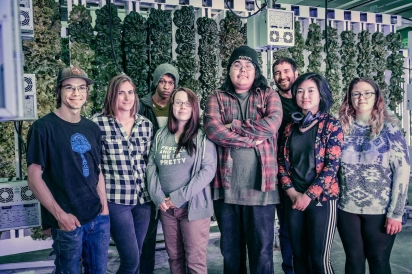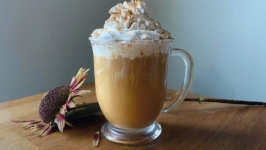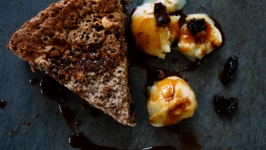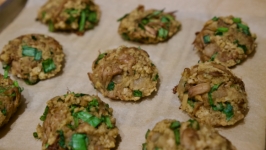Mushroom Magic
On a brilliant blue sky summer evening, Allison Dunbar and Gabriel DeGange, founders of Far North Fungi, are busy working. Off the highway in Chugiak, at a beckoningly bright teal apartment building on the edge of the forest, a twelve-year-old Beethoven dog sits by the entrance to the basement, drooling. “That’s Mr. Hurley,” Gabe says, affectionately petting his head.
We walk past Mr. H., forever dubbed “Guardian of the Mushrooms” in my mind, out of the sunlight and down the ramp into the couple’s newly renovated business space. It’s transformation into “The Lab” is nearly complete. A jar with wildflowers sits at the entrance. A futon is next to the wall, since late nights are typical right now. Despite these homey touches, it feels so industrial that I quickly forget we are in someone’s basement until we hear footsteps shuffle upstairs. “Little bit of trivia,” Gabe laughs. “Ted Sadtler (Mattress Ranch founder) started his business in here.” Seems like a good sign.
For the founders of this nascent Anchorage company, the new lab is an important and celebratory step, one that symbolizes the growth of their business and new opportunities to come.
Growing a Business from Spore to Market
I first met Allison and Gabe mid-bite into some blue oyster pâté on toast, served during a house party for their inaugural mushroom harvest in February 2017. At the time, with snow still frozen on the ground, friends and family toured the extra bedroom they had converted into their original lab. Both have a background in lab work and a connection to food. Gabe trained at the Fort Collins based U.S. Geological Survey (USGS) Molecular Ecology Laboratory in genetics, and then fished commercially; Allison cut her teeth in virology labs and at a mushroom farm in Atlanta, where she readily acknowledges how fortunate she was to have had a mentor teach her every stage in the cultivation process.
The next time you go on a Costco run and buy mushrooms, they will likely be the smooth and mild-tasting white buttons exported from Chester County, Pennsylvania. This small rural region is home to 61 mushroom farms and is the largest producer of fresh mushrooms in the United States, growing an estimated 47% of our nation’s commercial fungi. Allison and Gabe focus on growing mushroom varieties not commonly sold around town. Their current specialties are blue oyster, lion’s mane (which looks like a woodland sea anemone), black poplar, and reishi mushrooms. They sell fresh mushrooms by the pound, and use them to make tinctures and savory powders for adding to soups or popcorn.
All commercial mushrooms are grown indoors, in carefully controlled environments. It’s a scientific process every step of the way. Beginning with sterilizing bags in their 96 gallon water trough and determining light spectrum and oxygen levels, it requires attention to detail, experimentation, and a lot of repetition. Allison and Gabe explain the process, using phrases like “flow hood” and “0.3 micron filter” as they detail their meticulous methods, and are serious about data collection to document growth cycles and findings. From petri dish to harvest, mushrooms take about three to six months to cultivate. Blue oysters have the fastest cycle at three months. Lion’s mane take 4-5 months, and shiitakes take up to six months to be ready to eat.
Although the technical aspects can be dizzying, after just a few minutes of talking to the couple it’s easy to fall in love with mushrooms. Even if you’re not a self-identified fungi fan, their enthusiasm and passion is infectious. As soon as I entered their world of fungus and grains, peering into petri dishes, and searching for shiitakes in heaps of hay, I knew I would never look at a mushroom the same way again.
“We are fruiting substrate,” Allison explains, beckoning me to the rows of pantry style shelving filled with bags in the early production stage of the fungi life cycle. Rather than seed packets, farmed mushrooms start from spores in petri dishes feeding off agar, a substance most commonly used to make jelly.
Gabe excitedly holds up a bag of the colonized mushroom block, just beginning to incubate. At first glance, it appears to be a heavy plastic bag filled with moldy oats. But looking closer, the white mycelium growth on the grain is an entire constellation of growing microbes, action-packed and soon to be incredibly delicious.
Making the leap from backyard enthusiasts to commercial mushroom farmers is a challenge, but one that Gabe and Allison are up for. The bigger lab will allow them to grow a larger yield, and supply more food to an eager and hungry consumer and restaurant market.
Cooperative Hydroponics
The next day we meet in the parking lot of the Anchorage Community Mental Health Services, where the Seeds of Change hydroponic farm is located. Gabe and Allison are busy unloading three dozen mushroom bags onto a cart for an experiment in CO2
production. We head inside and meet program director Ryan Witten under the purple fluorescent grow lights. The bags are unloaded into “Sprout City,” the germination chamber in the back corner where all of the herbs and leafy greens start from seed. The oyster mushrooms will incubate here for 2-3 weeks, with the heavy exhaust of CO2 from the mushrooms helping the seedlings grow faster.
It’s a trial run, but within minutes of lining the mushroom bags up on the top shelf the CO2 meter is already up ten points. “Whoa, I didn’t expect that to happen SO fast!” Gabe whoops. The trio are all smiles.
“I don’t know of any large scale partnerships between mushroom and hydroponic growers,” Gabe tells me. It’s a new relationship, but already both parties are dreaming of exploring creative next steps, such as installing a dry cleaning rack from the ceiling to hang bags on, circulating them over the entire hydroponic farm. Witten is thrilled, both about the symbiotic relationship, as well as the new opportunity for Seeds of Change youth. “We are really excited to expose our staff to more entrepreneurs in the community,” he says.
A Mycological Meeting
Back in the lab, Allison takes a signed copy of Paul Stamets book “The Mushroom Cultivator” off the shelf, where it’s kept with a handful of other mushroom-themed books. Our nation’s most famous mycologist, Stamets unwittingly played a role in bringing Gabe and Allison together.
Growing up in Southern Appalachia, Allison reminisces about making mushroom kits with her moms on cookie sheets in their home kitchen, and going on outings with the Georgia Mushroom Club.
In 2013, at a seminar teaching students how to grow mushrooms as a way to break down contamination, Allison and Gabe crossed paths. Later, they would realize that years previously they had been listening to the same (now legendary) talk by Paul Stamets on environmental remediation: Allison in person and Gabe watching by a video conference across the country. Allison said she saw the talk and thought to herself, “This is it. This is what I want to do.” She is now at University of Alaska Anchorage pursuing a degree in civil engineering with a minor in biology.
A Walk on the Wild Side
Far North Fungi is not only about indoor lab cultivation. The couple love to adventure together in the outdoors and search for wild mushrooms. Some years, like last summer, they are able to harvest hundreds of pound of morels to sell to restaurants or at the farmers market. Other times, it’s more about being in nature. In between Saturday markets they may head out on a mountain bike trip to Lost Lake, both for recreation and to scope out the scene for King boletes. Allison shows a picture on Gabe’s phone of a bright yellow edible fungus they found near Seward called witches butter. “It’s … gelatinous,” she says, laughing.
It’s been a year and a half since the launch of their business, and there is already more demand than they can grow supply for. Fred Meyer’s has offered to sell their mushrooms if they can grow enough for wholesale. Local food distributor Arctic Harvest includes their product in their CSA and delivers it to restaurants. Gabe and Allison are hoping their new partnership with Seeds of Change will help free up some time to do more experimentation growing mushrooms to help solve problems. They have big ideas about mycoremediation, a form of bioremediation that uses fungi-based technologies, and are conducting a research project at the Ted Stevens International Airport cultivating mushroom varieties that will be able to clean up diesel contamination around the state. Allison is working with a UAA professor to develop a toxic-free mushroom insulation that can be used for housing. Gabe dreams of ways to make a compostable fish cooler made from mushroom particle boards, rather than using styrofoam or plastic.
At the end of the day and in their hearts, they are scientists and engineers. They love the chemistry, biology, and experimentation of growing mushrooms, and the opportunities are seemingly endless.











